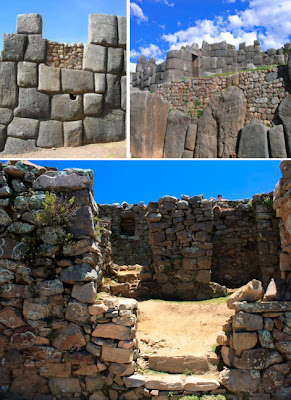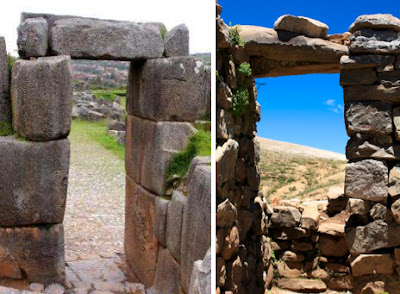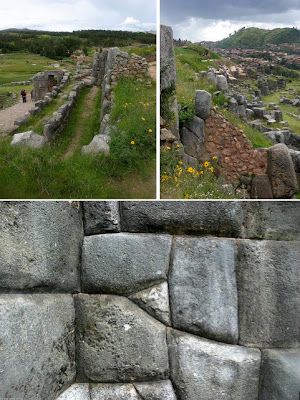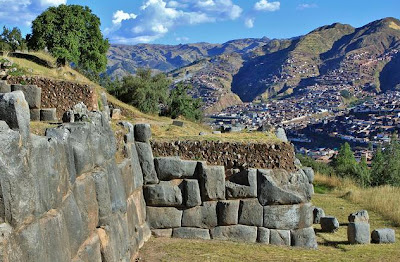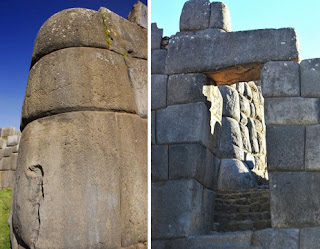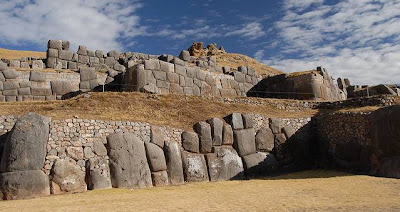Another problem we have with
archaeology and anthropology is their nature of naming each city area a
different name and culture. Often this is based upon style—style of
architecture, of pottery, and of other artifacts. If pottery styles are
different, then it is automatically assumed they came from different cultures,
even if found in the same location. If architecture is different, the buildings
were built by different cultures. Another factor is distance, even if ceramics
or architecture is the same or similar, if the distance is beyond an attributed
area to a culture then, again, it is a different culture.
Take Kuelap, as an example. It
was built, like the Moche coastal pyramids, in stages as a series of platforms,
one atop the other. However, to the scholar, these were two entirely different cultures.
On the other hand, the Moche civilization is said to have begun during the fall
of the Cupisnique era at about the time of Christ. Yet these two civilizations slowly
merged into one, still named the Moche, after a river that flows into the ocean
just south of Trujillo. Though the two cultures followed each other, there is
no thought that they were a continuation of the same culture.
Left: Cupisnique culture clay architecture;
Right: Chimu culture clay architecture at Chan Chan; Bottom: Sican culture clay
and mud brick architecture too ruined to tell what similarities might
exist—however, some comparisons suggest a connection which many scholars ignore
Yet, both the Moche and the
Cupisnique existed along Peru’s Pacific coast, with the Cupisnique, according
to Alana Cordy-Collins, flourishing from 1000 B.C. to about 200 B.C., which just
so happens to be the same dates attributed to yet another culture, the Chavin.
In addition, the Cupisnique had a distinctive style of adobe clay architecture
but shared artistic styles and religious symbols with the later Chavin culture,
which followed them. Yet, the relationship between Chavin and Cupisnique is not
well understood, and the names are sometimes used interchangeably, though other
scholars believe the Cupisnique developed separately from the Chavin.
Izumi Shimada thinks the
Cupisnique were ancestors of Michica (Moche), with no connection to the Chavin,
yet Anna C. Roosevelt refers to "the coastal manifestation of the Chavin
Horizon dominated by the Cupisnique style." Some scholars believe the Cupisnique
culture fell into powerful Chavin influence and was assimilated into it. The
point is, there is no clear-cut determination in determining these separate
cultures—it is merely guesswork based upon the individual scholar’s views and
beliefs.
In
the area that belongs to the Cupisnique culture and is demarcated by Virú and
Lambayeque river valleys, there were, in ancient times, several ceremonial and
population centers fitted out with monumental temple plains plus a great many
smaller villages. Within the Cupisnique culture, it is claimed there was no
uniform state—it was more a question of unity brought about by similar beliefs
and art. Similar beliefs and art? Then what makes them different cultures? Why
are they not considered to be the same people, simply with different art
interests, abilities, or visions? Mostly, the Cupisnique have been set apart by
the ceramic style archaeologists attribute to them.
To compound this even further,
the Chavin, Tiwanaku, and the Chachapoyas, all of which, according to the
scholars, are considered to be totally different cultures, even existing at
different times, yet, all have at least one very distinctive thing in common
and that is the use of carved heads along walls.
Top: Iconic carved stone heads on the walls of the pyramid
at Chavin de Huantar, located 160 miles north of Lima, east of the Cordillera
Blanca, in the Conchuycos Valley, about 850 B.C. to about 300 B.C.; Middle:
Carved stone heads built into the temple wall at Tiwanaku, south of Lake
Titicaca, around 500 B.C. to about 500 A.D.; Bottom Left: Carved head built
into the wall at Gran Saposoa, located in the high Amazon
jungles of Peru; Bottom Right: Head carved into the stone wall at Kuelap
in northern Peru, believed to be the Chachapoyas culture
Were several of these cultures
actually the same people as they progressed through the centuries, learning to
do things differently, spreading into different areas, which required building
with different natural resources available in new areas. Were these people
learning better, more improved, or simply different artistic talents,
abilities, form or design? The three ancient rock carved heads below were found
at three different sites, all attributed to the Chachapoya, though the sites
were scattered over a wide area. In fact, one of the sites, recently
discovered La Meseta, in the upper Amazon on the eastern slope of the Andes
Mountains, which was considered far outside the previously believed Chachapoya
culture geographical influence. Consequently, archaeologists believe the
Chachapoya were hired to build that site, or might have been pressed into slave
labor. For some reason, scholars never seem to consider they were the same
people simply moving into other areas, or that all those northern Peru sites
were settled by the same people.
Three more rock carved heads from various sites, all attributed to the
Chachapoya culture, yet are in far flung areas
Another example is that the
Chachapoya are renowned for their mountain-top citadels, such as Kuelap, Gran
Pajaten and Vir Vira, all in northern Peru, yet the mountain-top citadels of
Sacsayhuaman, Pisac, and Machu Picchu, to name a few, are not attributed to the
Chachapoya.
Another oddity of archaeological
and anthropological reasoning is that Ollantaytambo is considered a pre-Inca
site, but Sacsayhuaman and Machu Picchu are considered to have been built by
the Inca. Yet, all three sites have the unique massive rocks, perfectly carved
and fitted, with protuberances, possibly used for movement of the large stones,
and trapezoidal openings for doorways and window openings.
Top images of Machu Picchu and bottom images from Sacsayhuaman; Note
the same sharp angle cuts and slightly bulged large stones on the left images,
and the same cut stones perfectly fitted without mortar in the right photos.
Both structures show the same artistic, engineering and design ability, yet
Sacsayhuaman was built more than a thousand years before Machu Picchu is said
to have been constructed, the former by a pre-Inca people, and the latter by
the Inca
Left: Rock protuberances on stonework: Top Left: Cuzco; Right:
Ollantaytambo; Bottom Left: Machu Picchu; Center: Ollaytaytambo; Right:
Coriancha
Here is a strong example of
similar and even identical construction built over widely different periods,
yet attributed to the same people, or in some cases, to different people.
(See the next post, Different
Cultures or the Same? Part II, for more information showing how so-called
different cultures may, in fact, have been one, or only a few, groups of
people)





















